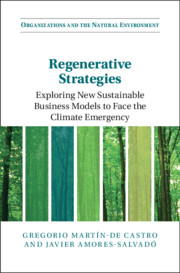Book contents
- Regenerative Strategies
- Organizations and the Natural Environment
- Regenerative Strategies
- Copyright page
- Contents
- Figures
- Tables
- Foreword: Reversing Course
- Acknowledgements
- 1 Introduction
- 2 Assessing the Response to the Climate Grand Challenge
- 3 Business as Usual
- 4 Sustainable Business Models
- 5 Climate Emergency in the Anthropocentric Era
- 6 The Regenerative Strategy
- 7 The Regenerative Strategy
- 8 Concluding Remarks
- Index
- References
6 - The Regenerative Strategy
Published online by Cambridge University Press: 28 March 2024
- Regenerative Strategies
- Organizations and the Natural Environment
- Regenerative Strategies
- Copyright page
- Contents
- Figures
- Tables
- Foreword: Reversing Course
- Acknowledgements
- 1 Introduction
- 2 Assessing the Response to the Climate Grand Challenge
- 3 Business as Usual
- 4 Sustainable Business Models
- 5 Climate Emergency in the Anthropocentric Era
- 6 The Regenerative Strategy
- 7 The Regenerative Strategy
- 8 Concluding Remarks
- Index
- References
Summary
Chapter 6 constitutes the core proposition of this book, in which the regenerative strategy is explained. Jointly with the theoretical arguments, two main figures capture the main characteristics of this disruptive environmental strategy, which is composed of two main elements: (1) a disruptive technological solution capable of fighting against the climate emergency through pollution reversion, net zero and even net negative emissions, which constitutes the creation of positive environmental externalities; and (2) a new firm purpose, driven by a new ecological, ethical and moral value that we name ‘eco-emotional wealth’, guiding environmental performance and, finally, the achievement of systemic socioecological resilience. To do so, we advocate a new approach to stakeholder management including unconventional and fringe stakeholders, such as communities, governments, global citizenship, the natural environment and future generations, jointly with a new very long-term perspective.
Keywords
- Type
- Chapter
- Information
- Regenerative StrategiesExploring New Sustainable Business Models to Face the Climate Emergency, pp. 139 - 178Publisher: Cambridge University PressPrint publication year: 2024



